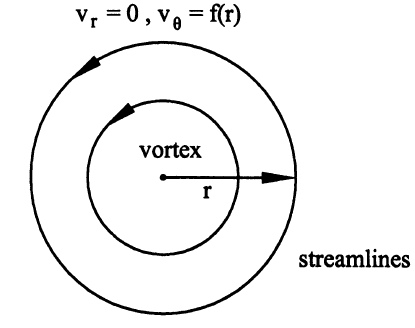A forced vortex flow is given by \nu =r\omega _{\omicron }\hat{e}_{\theta }, where \omega _{\omicron } is constant (Fig. 8.16). Determine if Bernoulli’s equation can be used to determine the pressure differ-ence between two radial locations. Ignore gravity.
Question 8.9: A forced vortex flow is given by v=rωoeθ, where ωo is consta...

The Blue Check Mark means that this solution has been answered and checked by an expert. This guarantees that the final answer is accurate.
Learn more on how we answer questions.
Learn more on how we answer questions.
For \nu _{r}\hat{e}_{r}+\nu _{\theta }\hat{e}_{\theta }+\nu _{z}\hat{e}_{z}, we have
\nu _{r}=0, \nu _{\theta }=r\omega _{\omicron }, \nu _{z}=0.FIGURE 8.16 Schema of a vortex flow. In a forced vortex, \nu _{\theta }=r\omega , whereas in a free vortex, \nu _{\theta }=c/r, where c is a constant. What is the vorticity for each?.
Fundamental Balance Relations To use the Bernoulli equation, several assumptions must be met:
1. The flow must be steady. Checking in each direction, we get
thus, this restriction is satisfied.
2. The fluid must be incompressible. For cylindrical coordinates,
\triangledown \cdot \nu =\frac{1}{r}\frac{\partial}{\partial r}(r\nu _{r})+\frac{1}{r}\frac{\partial}{\partial \theta }(\nu _{\theta })+\frac{\partial}{\partial z}(\nu _{z}).Checking \triangledown \cdot \nu =0, we get
\frac{1}{r}\frac{\partial}{\partial r}(r(0))+\frac{1}{r}\frac{\partial}{\partial \theta }(\nu \omega _{\omicron })+\frac{\partial}{\partial z}(0)=0;thus, this restriction is satisfied.
3. Under certain situations, we can assume that the fluid is inviscid. The validity of this assumption must be established via experience.
4. The flow must be along a streamline or it must be irrotational, where \triangledown \times \nu =0. For cylindrical coordinates, \triangledown \times \nu =0 is given by
With \nu _{r}=\nu _{z}=0, we have
\triangledown \times \nu =\left(-\frac{\partial \nu _{\theta }}{\partial z} \right)\hat{e}_{r}+\left(\frac{1}{r}\frac{\partial (r\nu _{\theta })}{\partial r} \right)\hat{e}_{z}=\frac{1}{r}\frac{\partial (r^{2}\omega _{\omicron })}{\partial r}\hat{e}_{z}or, in the z direction,
\frac{1}{r}(2r\omega _{\omicron })=2\omega _{0}.Therefore, the flow is not irrotational, and Bernoulli’s equation cannot be used unless along a streamline.
Related Answered Questions
Because we do not know \nu as a fun...
For flow along a streamline between points 2 and 4...
\triangledown \cdot \nu =\frac{\partial}{\p...
Assuming that we know the cross-sectional area wit...
Given:
z_{1}=0
A_{1}=\pi...